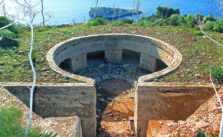The Greek capital hasn’t given up all of its secrets yet, despite evidence to the contrary in this day and age of rampant tourism and social media posts from – seemingly – every nook and cranny in Attica. One persistent explorer, Konstantinos Kyrimis, an independent researcher and writer, has made it his business to root out its unseen facets, even if they are right in front of us, in a manner of speaking.
Such facets include three imposing World War II fortifications that lie forgotten just a short distance from Athens’ southern coast, including labyrinthine tunnels and hidden underground structures on the island of Aegina, not far from the better-known Temple of Aphaia.
Combining his love of war history and urban history, Kyrimis recently carried out a field study on the islands of the Saronic Gulf, where he located the remnants of the three naval fortifications built during the dictatorship of Ioannis Metaxas.
Kathimerini spoke with the researcher about the Saronic Defense Line on the occasion of the release of the second edition of his study, “Underground Naval Fortifications in Attica, 1936-1994,” which has been published, in Greek only, by the Hellenic Institute of Naval History.

“I was surprised when I first heard about World War II naval fortifications on Aegina, an island best known by Athenians as a weekend destination rather than a piece of modern military history,” said Kyrimis.
How did he go about his research? “I started with the archives of the Naval History Department, the body responsible for safeguarding and managing the Hellenic Navy’s Historical Archive, which is headquartered in Votanikos. I spent many hours there and discovered that, apart from preparing its fleet, the Navy at the time was working on an ambitious plan to fortify the Saronic in such a way as to prevent the enemy from landing but also from passing through,” he says.
What constituted this plan?
“The Higher Coastal Defense Command, a division of the Hellenic Navy, was established under Ioannis Metaxas in 1936 with the aim of controlling naval passages. Administratively, it divided the entire country into six naval defense areas (NAP), with the most important being NAP 3, headquartered in Piraeus and responsible for the Saronic Gulf. In simple terms, they devised a plan on how to block enemy forces if they attempted to attack the Salamina Naval Base and the port of Piraeus. This involved building three naval forts: at Perdika on Aegina’s southern coast, at Cape Tourlos on Aegina’s northern coast, and one more on the islet of Fleves off the coast of Vouliagmeni. A few more auxiliary structures were also built, but these were the main fortifications,” Kyrimis explains.
“If the enemy wanted to land in Athens or attack Piraeus with their ships, they would have to pass either through naval mines or narrow sea corridors between these three fortresses, where the cannons would sink them. With a firing range of up to 20 kilometers, these fortifications effectively ‘locked’ in anything passing in front of them. They even built all the forts underground so they could not be spotted and destroyed. It would be almost impossible for an enemy ship passing by to see them, and even if it did, it would be even less likely that it would defy the cannon fire to destroy it,” he adds.


The fort at Tourlos had the biggest area of oversight and was armed with four cannons, making it the strongest of the three. For cost-saving reasons, these cannons, like the other guns at the forts, had been stripped from the decommissioned frigate Limnos. “It was quite an accomplishment and would be extremely complicated even today,” says the writer.
“The massive guns, weighing several hundreds tons, were detached from the frigate at the Salamina Naval Base and transported to Aegina and then hoisted all the way to the top of the hill overlooking Tourlos, where massive holes had to be excavated to accommodate the guns and their towers. What’s more, the walls of these bunkers were buttressed with 60-80-centimeter walls made of fortified concrete and topped with steel. What they did, effectively, was turn the hill into an unsinkable warship!”
Kyrimis’ study contains all sorts of fascinating technical details about the fortifications’ equipment, such as that their turrets were equipped with two guns each and were installed within a specially excavated hole, measuring 10 meters in depth and diameter. A trench of sorts was dug around each turret to accommodate auxiliary spaces, such as ammunition storage and steering systems. The forts were also equipped with impressive searchlights featuring 2-meter diameter mirrors, which were hidden underground to avoid detection and raised by a special mechanism. They additionally had an underground electric station with four German diesel generators, reflecting the expertise that the Hellenic Navy had acquired from the Germans.
“This is a historically interesting tidbit, as it stands in contrast with the Army, which chose to cooperate with the French on the northern border, at the so-called Metaxas Line,” notes Kyrimis. “For its defensive lines, the Navy instead put its trust in the Germans and three consultants were sent to Greece from that country in 1936 to share their know-how – and sell German products in the process. For example, the Navy had foreseen beds for the men manning the forts, but these took up too much room. The consultants recommended replacing them with (German-made) folding metal cots, which allowed more men to be accommodated. Similar purchases were made of German air-filtration devices to be used in the event of an attack with chemical weapons.”
The Navy also planted hundreds of trees on Fleves and Aegina, says Krymnis, explaining that this served two purposes: “First, to camouflage the forts from the eyes of the enemy in the air and, secondly, for reasons of self-sufficiency as the men could grow fruit. What’s more, the fields surrounding the forts were often leased to citizens, meaning they generated revenue. These trees allowed the Navy to make some money, hide from the enemy and have access to food. So, you see, we’re not talking about simple concrete constructions, but complex ‘ecosystems.’”
Attica’s ‘Metaxa Line’
In order to be effective, the bar had to be set very high for these ambitious projects. “The standards were very high indeed,” Kyrimis confirms. “They were so strict and demanding that these three forts were often referred to as ‘Attica’s Metaxa Line,’ being likened to the well-known fortifications on the Greek-Bulgarian border.”
Ultimately, however, these remarkable yet little-known structures erected by the Hellenic Navy to fortify critical passages of the Saronic Gulf were never used in combat. The impressive cannons, hidden and battle-ready within their underground turrets, though fully prepared to defend Athens, never had to do so.


“Indeed,” says Kyrimis. “Had they not been there, though, perhaps the enemy would have attempted a landing or an attack on the naval base. They may not have known the details, but they knew we had taken precautions to protect ourselves. Even though they never had to defend our waters, these first also protected Attica’s skies, as a significant part of the region’s air defense relied on their anti-aircraft guns, which, it must be noted, achieved a small number of shootdowns.”
Looking ahead, Kyrimis says he hopes that the Hellenic Navy starts taking better advantage of these “impressive but largely unknown” fortifications by opening them to the public at least a few days a year and, perhaps, turning some of the spaces into a museum.

